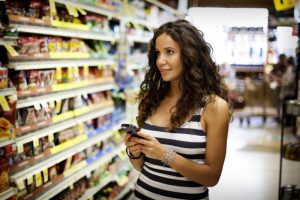 I was standing in the greeting card and seasonal gift aisle at my local grocery store recently surrounded by Valentine’s Day goodies. All the other shoppers standing in the aisle with me looked as perplexed as I felt. Should I throw in the towel, succumb to pressure, and get my Valentines the standard chocolate sampler in a heart-shaped box, or would inspiration strike and lead me to something more original?
I was standing in the greeting card and seasonal gift aisle at my local grocery store recently surrounded by Valentine’s Day goodies. All the other shoppers standing in the aisle with me looked as perplexed as I felt. Should I throw in the towel, succumb to pressure, and get my Valentines the standard chocolate sampler in a heart-shaped box, or would inspiration strike and lead me to something more original?
Like Cupid’s arrow, it struck me that a similar dynamic is in play for grocery retailers wanting to connect with customers roaming the aisles with smart phones blazing. Sure, they can be content to let customers sleep walk through the store while picking up essentials for tonight’s supper. Or, the retailer can use collected data in a variety of ways that uphold the brand promise, delight the customer, improve inventory productivity and, ultimately, grow profits.
Here are some tips for how retailers can use data and show their customers some love:
Love means not always offering a promotion. As consumers lean toward buying more middle-of-the-store basics online, grocers must step up their game and use data to give consumers new reasons to come to a bricks-and-mortar store. For example, if you know Pete buys the ingredients for Wednesday spaghetti night every week, help him take it up a notch from marinara with spaghetti noodles. Inspire him to make something his family will enjoy and remember. How about an easy recipe for Chicken Piccata with a built-in shopping list sent to his smart phone? Easier still, send a reminder to Pete’s smart phone alerting him to your store’s new take-and-bake display near the front of the store with this week’s featured Chicken Piccata meal to heat and eat at home.
 It’s a match. Data can help a retailer play matchmaker by keeping the right merchandise in the right store at the right time. Customer satisfaction and loyalty increases when Pete knows he’ll be able to reliably find the Italian roast coffee he loves in the store 10 minutes from his home rather than the outlet across town. On that trip to buy morning beans, he might also be inspired to buy cage-free eggs, artisanal goat cheese and fresh herbs to make an omelet for the brunch that complements the coffee. A retailer that remains true to its brand promise by paying attention to its data and its customer base will come out on top.
It’s a match. Data can help a retailer play matchmaker by keeping the right merchandise in the right store at the right time. Customer satisfaction and loyalty increases when Pete knows he’ll be able to reliably find the Italian roast coffee he loves in the store 10 minutes from his home rather than the outlet across town. On that trip to buy morning beans, he might also be inspired to buy cage-free eggs, artisanal goat cheese and fresh herbs to make an omelet for the brunch that complements the coffee. A retailer that remains true to its brand promise by paying attention to its data and its customer base will come out on top.
Keep it local. Retailers also can leverage data to decide on the locations for new stores. By using buying pattern, loyalty and demographic data, a retail chain can determine the optimal ZIP code and street corner for the next outlet to open its doors. Well-known East Coast grocery chain Wegman’s is using such data – and creating quite a buzz in SAS’s neighborhood in North Carolina - to evaluate a prospective expansion site.
In the end, using data can mean the difference between having a fling and establishing a satisfying, long-lasting relationship with your customer.
Learn more about using analytics to make sure customers get exactly what they want.

